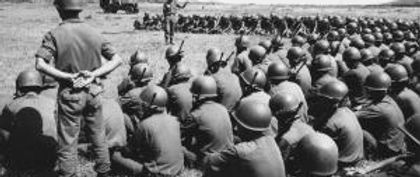
Vietnamization
Many communist losses during the Tet Offensive allowed U.S. President Richard Nixon to begin troop withdrawals. His plan, called the Nixon Doctrine, was to build up the ARVN, so that they could take over the defense of South Vietnam. The policy became known as "Vietnamization". Vietnamization had a lot in common with the policies of the Kennedy administration. While Kennedy insisted that the South Vietnamese fight the war themselves, he attempted to limit the scope of the conflict. This brought a total reduction of 265,500 men in our armed forces in Vietnam below the level that existed when they took office 15 months before.On October 10th 1969, Nixon ordered 18 B-52s loaded with nuclear weapons to race to the border of Soviet airspace to convince the Soviet Union, to prove that he was capable of anything to end the Vietnam War.The anti-war movement was gaining strength in the United States. Nixon appealed to the "silent majority" of Americans who he said supported the war without showing it in public. But revelations of the My Lai Massacre, in which a U.S. Army raped and killed civilians, and the 1969 "Green Beret Affair" where eight Special Forces soldiers, including the 5th Special Forces Group Commander were arrested for the murder of a suspected double agent provoked national and international outrage.Beginning in 1970, American troops were being taken away from border areas where most of the fighting took place, and instead put along the coast and interior, which is one reason why casualties in 1970 were less than half of 1969's totals.The war was the central issue of the 1972 U.S. presidential election.

Nixon's opponent, George McGovern, campaigned on a platform of withdrawal from Vietnam. Nixon's National Security Advisor, Henry Kissinger, continued secret negotiations with North Vietnam's Le Duc Tho. In October 1972, they reached an agreement.However, South Vietnamese president Thieu demanded big changes to the peace accord. When North Vietnam went public with the agreement's details, the Nixon administration claimed that the North was attempting to embarrass the president. The negotiations became deadlocked. Hanoi demanded new changes.To show his support for South Vietnam and force Hanoi back to the negotiating table, Nixon ordered Operation Linebacker II, a massive bombing of Hanoi and Haiphong December 18th-29th, 1972. The offensive destroyed much of the remaining economic and industrial capacity of North Vietnam. Nixon pressured Thieu to accept the terms of the agreement, threatening to conclude a peace deal and cut off American aid.On 15 January 1973, Nixon announced the suspension of offensive action against North Vietnam. The Paris Peace Accords on "Ending the War and Restoring Peace in Vietnam" were signed on January 27, 1973, officially ending direct U.S. involvement in the Vietnam War. A cease-fire was declared across North and South Vietnam. U.S. prisoners of war were released. The agreement guaranteed the territorial integrity of Vietnam and, called for national elections in the North and South. The Paris Peace Accords stipulated a sixty-day period for the total withdrawal of U.S. forces. "This article", noted Peter Church, "proved... to be the only one of the Paris Agreements which was fully carried out."

Toll Free: 1.800.555.2658
Monday - Friday: 9 a.m. - 5 p.m. PST
vietnamwar@waremails.com
